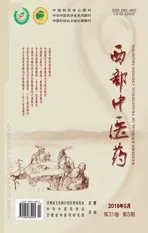天然黄酮类化合物抗肿瘤作用机制的研究
2018-02-14王哲元张有成
王哲元,张 璐,张有成
兰州大学第二医院,甘肃 兰州 730030
黄酮类化合物是自然界分布较广的具有2-苯基色原酮(flavone)结构的一系列化合物,是药用植物中的主要活性成分之一,具有丰富的药理作用。黄酮类化合物可分为以下几类:黄酮醇、黄烷、黄烷酮、花色素、黄酮类、异黄酮和新黄酮类聚合物。它们普遍存在于水果、谷物、豆类、蔬菜、坚果、中草药、香料、花朵以及部分饮料如茶、可可、啤酒和红酒中。早期研究[1]发现,人均每天黄酮苷类混合物的饮食摄取量平均在0.5~1 g。在亚太、地中海地区以及素食人群中,黄酮苷的日常饮食摄取量普遍较高,同时该地区及人群中结肠癌、前列腺癌和乳腺癌的发病率也较低。国内外研究[2-3]表明,天然黄酮类化合物能够通过修饰和调节宿主的酶系统参与细胞表面信号转导、免疫功能、细胞分化、肿瘤增殖和转移等,其中一些机制可能与抗肿瘤有关。目前已有多种黄酮类化合物作为抗肿瘤药物进入临床试验阶段。本文拟通过对天然黄酮化合物的抗癌活性,包括诱导凋亡、抑制细胞增殖、抑制蛋白酪氨酸激酶活性、抗侵袭转移和抗血管再生等的研究进展进行综述。
1 抑制肿瘤细胞增殖
过去30年研究表明,黄酮化合物对多种肿瘤细胞具有明显的抑制作用。Suolinna等[3]研究发现槲皮素对艾氏腹水癌细胞L1210和恶性淋巴瘤P-388细胞具有抑制作用;Edwards等[4]探讨了黄酮醇、黄酮和异黄酮的体外抗肿瘤活性和细胞毒性,发现槲皮素和 5,7,3′,4′- 四羟基 -3- 糖基黄酮对沃克癌256具有抗肿瘤活性;Molnar等[5]报道了多羟基化黄酮对小鼠腹水瘤的抗肿瘤活性。
天然黄酮类化合物对肿瘤细胞的抑制作用,可能与其抑制跟细胞增殖有联系的生化反应有关。例如,槲皮素阻止了肿瘤细胞的有氧糖酵解[3];黄酮醇抑制了艾氏腹水瘤细胞的DNA、RNA和蛋白合成[6]等。
槲皮素抑制各种酪氨酸激酶的能力可能是其抗肿瘤细胞增殖的机制。Cunningham等[7]的初步研究结果显示,槲皮素降低了表达Abelson酪氨酸蛋白激酶的Abelson-transformed肝癌细胞NIH 3T3细胞的生长;Ferry等[8]报道槲皮素抗肿瘤临床Ⅰ期试验发现,经过弹丸式静脉注射,血浆槲皮素能通过抑制淋巴细胞的蛋白酪氨酸磷酸化而抑制肿瘤。同时,槲皮素还能通过抑制蛋白酪氨酸激酶的活性来增强顺铂的抗肿瘤增殖作用[9]。
另外,Kioka等[10]报道槲皮素通过抑制P多糖的合成和多药耐药基因(MDR1)mRNA的聚集以此削弱肝癌细胞HepG2中MDR1的表达,从而抑制肝癌细胞的生长。
2 诱导肿瘤细胞凋亡
肿瘤的发生不仅与细胞的异常增殖和分化有关,也与细胞凋亡的异常有关。诱导肿瘤细胞凋亡已成为治疗肿瘤的新靶点、新方向和抗癌药物新的筛选标准。黄酮类化合物可通过多途径诱导肿瘤细胞凋亡,包括参与肿瘤细胞凋亡基因调控,干预细胞凋亡信号传导途径,调节细胞因子等。
有研究[11]发现槲皮素能够介导肺癌细胞A549的凋亡,实验结果显示当槲皮素作用于A549细胞后,可使细胞凋亡基因(Bcl-2)表达下降30%,同时诱导细胞凋亡蛋白酶-3(caspase-3)/CPP32和细胞凋亡蛋白酶-7表达活化[11]。另有研究报道,槲皮素苷元可快速短暂诱导HL-60细胞中caspase-3/CPP32的活性,由槲皮素苷元处理过的HL-60细胞中能发现抗凋亡蛋白Mcl-1降低,其他Bcl-2家族蛋白表达水平不变[12]。
Shukla和Gupta等[13]发现芹菜甙元对前列腺癌DU145细胞的生长抑制和凋亡诱导作用,是通过调控细胞周期、破坏线粒体功能和抑制核因子Kappa B(NF-kB)等一系列分子事件来完成。从海漆(Excoecaria agallocha)中分离出的一种新的黄酮苷作为Hedgehog/锌指蛋白1(GLI1)信号通路介导的转录抑制剂,通过抑制GLI相关蛋白斑纹基因同源物(PTCH)和BCL-2的表达和阻止GLI1转录因子向肿瘤细胞核的迁移来诱导肿瘤细胞凋亡[14]。有研究[15]报道称黄芩甙能通过细胞周期阻滞和凋亡诱导作用降低前列腺癌细胞LNCap、PC3的增殖效应。
大多数黄酮类化合物都具有抗炎、抗氧化、免疫调节等作用。其中许多化合物通过产生肿瘤坏死因子(TNF)、白细胞介素2(IL-2)和干扰素(IFN)等细胞因子来提高机体免疫功能,发挥诱导肿瘤细胞凋亡的作用。
3 对肿瘤细胞周期的影响
细胞周期是一个非常复杂和精细的调节过程,在控制细胞发育增殖过程中起到了关键性作用,细胞周期进程的异常或中断会导致细胞增殖和细胞死亡(凋亡)之间的失衡,继而导致癌症的发生,因此,细胞周期可作为抗肿瘤药物的靶点,抑制癌细胞的无限增殖并诱导凋亡[16]。
四种叶下珠属植物(P.amarus,P.niruri,P.urinaria和P.watsonii)的提取物可介导前列腺癌细胞(PC-3)停滞于G0/G1期,人黑色素瘤细胞(MeWo)停滞在S期,并且在这两种细胞中表达亚二倍体峰。同时,叶下珠属植物提取物还通过激活半胱天冬酶诱导肿瘤细胞凋亡。它的抗癌特性可能与其检测到的黄酮类化合物(芦丁、槲皮素葡萄糖苷、槲皮素二葡糖苷、槲皮素鼠李糖苷等)有关[17]。有研究[18]报道水飞蓟宾(silibinin)通过阻滞肿瘤细胞周期G1期从而抑制细胞生长,导致细胞凋亡,这与其抑制周期蛋白依赖性激酶(CDK)活化,显著降低周期蛋白D1(cyclinD1)、CDK4和CDK6 的表达有关[18]。
4 抑制肿瘤血管生成及侵袭转移
肿瘤血管生成在肿瘤的发生发展中起到至关重要的作用,当恶性肿瘤大小超过1~2 mm3时,其继续生长与转移必须依靠新生血管提供足够的营养才能实现。近年来,抗肿瘤血管生成已成为肿瘤治疗的基础之一,成为最有希望的肿瘤导向治疗靶标。研究表明许多黄酮类化合物的抗肿瘤作用与其抑制肿瘤血管生成有关。
Fotis等[19]研究小组对黄酮类化合物如3-羟基黄酮、3′,4- 二羟黄酮、2′,3′- 二羟黄酮、非瑟酮、芹菜甙元、毛地黄黄酮进行研究,发现上述化合物均具有体外抑制血管生成和肿瘤细胞增殖的作用。其中芹菜甙元不仅可抑制VEGF的表达水平,而且还能通过抑制低氧诱导因子1(HIF-1)结合位点和降低细胞HIF-1α亚基的表达来抑制A549肺癌细胞血管内皮生长因子的转录活性。其抑制作用主要是通过磷脂酰肌醇3激酶(PI3K)/蛋白激酶B(AKT)/核糖体蛋白S6蛋白激酶β1(p70S6K1)和双微体蛋白2(HDM2)/p53通路来实现[20]。
基质金属蛋白酶(matrix metalloproteinases,MMPs)是一组含Zn2+、参与降解细胞外基质(extracellular matrix,ECM)的最重要的蛋白酶。目前研究已证实MMPs参与人体众多的生理和病理过程,其中MMP2和MMP9与肿瘤细胞的转移有关,因此可通过对MMP-2和MMP-9的抑制来预防肿瘤转移。
Ko等[21]研究发现:杨梅素对MMP2有较强的抑制作用,其机制与抑制蛋白激酶(PKC)转位、细胞外调节蛋白激酶(ERK)磷酸化和c-jun蛋白表达来阻断内源性或组织型纤溶酶原复合物(TPA)诱导的MMP-2的活性有关。槲皮素能够抑制前列腺癌PC-3细胞中MMP-2和MMP-9的表达,且呈浓度依赖性。100 μmol/L的槲皮素作用于前列腺癌细胞PC-3后,细胞的MMP-9酶原水平增高,而MMP-9水平显著降低[22]。体外实验证实染料木黄酮能抑制具有高度转移特性的乳腺癌细胞MDA-AM 231的侵袭,其作用与 MMP-9下调有关[23-25]。Ende和Gebhardt等[26]发现毛地黄黄酮和芹菜甙元能抑制MMP-2和MMP-9的活性。
5 抑制蛋白激酶活性
国内外研究[27-30]报道,黄酮类化合物对肿瘤细胞的抑制作用可能与它们干扰蛋白激酶参与的细胞增殖调节有关。在过去20年中,一系列研究发现黄酮类化合物对丝氨酸/苏氨酸和酪氨酸激酶有显著抑制作用[27,29]。理想状态下,蛋白激酶的抑制效应与能够引起该疾病的某种酶关系密切。此外,蛋白激酶抑制剂对增殖期或生长期肿瘤细胞中的蛋白激酶PKC、表皮生长因子受体(EGRF)、黏着斑激酶(PAK)展现出更显著的效应。
PKC具有Ca2+依赖性,是一类可使丝氨酸/苏氨酸残基磷酸化的蛋白激酶,在肿瘤的发展、有丝分裂、炎性细胞和T淋巴细胞功能发挥中起重要作用[31-33]。体外实验证明[34-36]黄酮类化合物对PKC有明显的抑制作用,其中槲皮素的效果最明显;Graziani等[37]发现槲皮素降低了劳斯肉瘤病毒转化基因产物的磷酸化活性。此外,另有研究[38]表明,槲皮素对HL-60细胞胞浆中的PKC有明显的抑制作用。同时,姜黄素能够与PKC竞争三磷酸腺苷(ATP),抑制肿瘤细胞内蛋白组分的磷酸化作用和降低成纤维细胞生长因子受体的活性。
EGFR本身具有酪氨酶激酶活性,与表皮生长因子(EGF)组合后可启动细胞核内的有关基因,从而促进细胞的分裂增殖。染料木黄酮是一种蛋白酪氨酸激酶抑制剂,能够抑制人淋巴瘤细胞HL-60和K-562的增殖并介导分化[39],另外,这种异黄酮抑制了鳞状细胞癌A431细胞EGFR酪氨酸激酶的活性[40]。而且,研究[41-42]发现染料木黄酮能够影响乳腺癌和前列腺癌的细胞周期调控,而且槲皮素和毛地黄黄酮对EGFR酪氨酸激酶的抑制作用较染料木黄酮更强[27,29]。槲皮素能够阻断EGFR信号转导途径,从而抑制肿瘤细胞MiaPaCa-2的生长并诱导凋亡[43]。
FAK为非受体型的酪氨酸激酶,存在于细胞质中,是一种重要的信号通路调节器,对细胞的存活、细胞周期以及细胞活动力的影响至关重要[44]。FAK在大多数肿瘤中高表达,据报道,它是肿瘤发生、侵袭和转移的重要决定因素[43]。研究[45-49]表明减弱FAK活性或使FAK去功能削弱了肿瘤的增殖和侵袭能力。毛地黄黄酮和槲皮素作用后的肿瘤细胞能阻止FAK磷酸化,从而抑制肿瘤细胞侵袭转移[50]。
6 其他
环氧合酶(cyclooxygenase,COX)是前列腺素(PG)合成过程中一个重要的限速酶,可将花生四烯酸代谢成各种前列腺素产物,从而在机体的生理和病理过程中发挥作用。COX-1和COX-2在许多良性癌前病变和恶性肿瘤中高表达,环氧合酶可能参与了恶性肿瘤的发生、发展。从植物Macaranga conifera中分离出8个二氢黄酮,通过评价这些化合物对COX-1和COX-2的活性,发现鱼藤醇(lonchocarpol)A和槐二氢黄酮(sophoraflavanone)B均具有抑制上述两种酶的活性,而且鱼藤醇A表现出了更强的活性,抑制COX-1和COX-2的IC50分别为 16.5和 9.5 μmol/L,同时通过DMBA诱导的乳房肿瘤前损伤模型来评价其抑制肿瘤的活性,鱼藤醇在10 mg/L时抑制率可达86.1%,有望成为潜在的抗肿瘤化疗药物[51]。Jang等[52]研究潜在的肿瘤化学防护剂中发现,3,7,3′,4′- 四甲基槲皮素、3,7,3′- 三甲基槲皮素和3,7-二甲基槲皮素具有诱导醌还原酶的活性,这与肿瘤化学防护机制密切相关。
综上所述,黄酮类化合物具有广泛的抗肿瘤活性,可影响与肿瘤发生发展相关的细胞和免疫进程,可通过多种途径抑制多种肿瘤细胞的增殖与转移,但其作用机制复杂,作用靶点各不相同,因此需要进一步对其抗肿瘤机制进行深入探讨。目前国内外对天然黄酮类化合物抗肿瘤作用的筛选仍在不断进行,应当充分利用我国中草药资源丰富的优势,加快该领域的研究,研发出具有更高活性的抗肿瘤新药。
[1]Kühnau J.The flavonoids.A class of semi-essential food components:their role in human nutrition[J].World Rev Nutr Diet,1976,24(24):117-191.
[2]Middleton EJr,Kandaswami C,Theoharidis TC.The impact of plant flavonoids on mammalian biology:implications for inflammations,heart disease and cancer[J].Pharmacol Rev,2000,52(4):673-751.
[3]Soulinna EM,Buchsbaum RN,Racker E.The effect of flavonoids on aerobic glycolysis and growth of tumor cells[J].Cancer Res,1975,35(7):1865-1872.
[4]Edwards JM,Raffauf RF,Quesne WL.Antineo plastic activity and cytotoxicity of flavones,is of lavones and flavanones[J].J Nat Prod,1979,42(1):85-91.
[5]Molnár J,Béládi I,Domonkos K,et al.Antitumor activity of flavonoids on NK/Ly ascites tumor cells[J].Neoplasma,1981,28(1):11-18.
[6]Graziani Y,Winikoff J,Chayoth R.Regulation of cyclic AMP level and lacticacid productionin Ehrlich ascites tumor cells[J].Biochim Biophys Acta,1977,497(2):499-506.
[7]Cunningham BDM,Threadgill MD,Hickman HA.Synthesis and evaluation of substituted flavones as inhibitors of tyrosine protein kinase[J].Br J Cancer,1987,56:207-213.
[8]Ferry DR,Smith A,Malkhandi J,et al.Phase I clinical trial of the flavonoid quercetin:pharmacokinetics and evidence for in vivo tyrosine kinase inhibition[J].Clin Cancer Res,1996,2(4):659-668.
[9]Hoffman J,Ueberall F,Posch L,et al.Synergistic enhancement of the antiproliferative activity of cis-diamminedichloroplatinum(II)by the ether lipid analogue BM141440,an inhibitor of protein kinase C[J].Lipids,1989,24(4):312-317.
[10]Kioka N,Hosokawa N,Komano T,et al.Quercetin,a bioflavonoid,inhibits the increase of human multidrug resistance gene(MDR1)expression caused by arsenite[J].FEBS Lett,1992,301(3):307-309.
[11]Yoder BJ,Cao S,Norris A,et al.Antiproliferative prenylated stilbenes and flavonoids from Macaranga alnifolia from the Madagascar rainforest[J].J Nat Prod,2007,70(3):342-346.
[12]Nguyen TT,Tran E,Nguyen TH,et al.The role of activated MEK-ERK pathway in quercetin-induced growth inhibition and apoptosis in A549 lung cancer cell[J].Carcinogenesis,2004,25(5):647-659.
[13]Shukla S,Gupta S.Molecular mechanisms for apigenin-induced cell-cycle arrest and apoptosis of hormone refractory human prostate carcinoma DU145 cells[J].Mol Carcinog,2004,39(2):114-126.
[14]Rifai Y,Arai MA,Sadhu SK,et al.New Hedgehog/GLI-signaling inhibitors from Excoecaria agallocha[J].Bioorg Med Chem Lett,2011,21(2):718-722.
[15]Ikezoe T,Chen SS,Heber D,et al.Baicalin is a major component of PC-SPES which inhibits the proliferation of human cancer cells via apoptosis and cell cycle arrest[J].Prostate,2001,49(4):285-292.
[16]Kastan MB,Bartek J.Cell-cycle checkpoints and cancer[J].Nature,2004,432(7015):316-323.
[17]Tang YQ,Jaganath IB,Sekaran SD.Phyllanthus sppinduces selective growth inhibition of PC-3 and MeWo human cancer cells through modulation of cell cycle and induction of apoptosis[J].PLo S One,2010,5(9):12644.
[18]Zi X,Agarwal R.Silibinin decreases prostate-specific antigen with cell growth inhibition via G1 arrest,leading to differentiation of prostate carcinoma cells:implications for prostate cancer intervention[J].Proc Natl Acad Sci USA,1999,96(13):7490-7495.
[19]Fotis T,Pepper MS,Aktas E,et al.Flavonoids,dietary derived inhibitors of cell proli feration and in vitro angiogenesis[J].Cancer Res,1997,57(14):2916-2921.
[20]Liu LZ,Fang J,Zhou Q,et al.Apigen in inhibits expression of vascular endothelial growth factor and angiogenes is in human lung cancer cells:implication of chemoprevention of lung cancer[J].Molecular Pharmacology,2005,68(3):635-643.
[21]Ko CH,Shen SC,Lee TJ,et al.Myricetin inhibits matrix metalloproteinase2proteinexpression and enzyme activity in colorectal carcinoma cells[J].Mol Cancer Ther,2005,4(2):281-290.
[22]Vijayababu MR,Arunkumar A,Kanagara P.Quercetin downregulates matrix metalloproteinases 2and9 proteins expression in prostate cancer cells(PC-3)[J].Mol Cellular Biochem,2006,287(1/2):109-116.
[23]Shao ZM,Wu J,Shen ZZ,et al.Genistein exerts multiple suppressive effects on human breast carcinoma cells[J].Cancer Res,1998,58(21):4851-4857.
[24]Shao ZM,Wu J,Shen ZZ,et al.Genistein inhibits both constitutiveandEGF-stimulatedinvasion in ER-negative human breast carcinoma cell lines[J].Anticancer Res,1998,18(3):1435-1439.
[25]Magee PJ,McGlynn H,Rowland IR.Differential effects of isoflavones and lignans on invasiveness of MDAMB-231 breast cancer cells in vitro[J].Cancer Lett,2004,208(1):35-41.
[26]Ende C,Gebhardt R.Inhibition of matrix metalloproteinase-2 and -9 activities by selected flavonoids[J].Planta Med,2004,70(10):1006-1008.
[27]Huang YT,Hwang JJ,Lee PP,et al.Effects of luteolin andquercetin, inhibitorsof tyrosinekinase,on cell growth and metastasis-associated properties in A431 cells overexpressing epidermal growth factor receptor[J].Br J Pharmacol,1999,128(5):999-1010.
[28]Sato F,Matsukawa Y,Matsumoto K,et al.Apegenin induces morphological differentiation and G2/M arrest in rat neuronal cells[J].Biochem Biophys Res Commun,1994,204(2):578-584.
[29]Lee LT,Huang YT,Hwang JJ,et al.Transinactivation of the epidermal growth factor receptor tyrosine kinase and focal adhesion kinase phosphorylation by dietary flavonoids:effect on invasive potential of human carcinoma cells[J].Biochem Pharmacol,2004,67(11):2103-2114.
[30]SoFV,GuthrieN,ChambersAF,etal.Inhibitionof human breast cancer cell proliferation and delay of mammary tumorigenesis by flavonoids and citrus juices[J].Nutr Cancer,1996,26(2):167-181.
[31]Nishizuka Y.Studies and perspective of protein kinase C[J].Science,1986,233(4761):305-312.
[32]Nishizuka Y.The molecular heterogeneity of protein kinase C and its implications for cellular regulation[J].Nature,1988,334(6184):661-665.
[33]Nishizuka Y.Protein kinase and lipid signaling for sustained cellular responses[J].FASEB J,1995,9(7):484-496.
[34]Agullo G,Gamet-Payrastre L,Manenti S,et al.Relationship between flavonoid structure and inhibition of phosphatidyolinositol 3-kinase:a comparison with tyrosine kinase and protein kinase C inhibition[J].Biochem Pharmacol,1997,53(11):1649-1657.
[35]Kang TB,Liang NC.Studies on the inhibitory effects of quercetin on the growth of HL-60 leukemia cells[J].Biochem Pharmacol,1997,54(9):1013-1018.
[36]Gamet-Payrastre L,Manenti S,Gratacap MP,et al.Flavonoids and the inhibition of PKC and PI 3-kinase[J].Gen Pharmacol,1999,32(3):279-286.
[37]Graziani Y,Erikson E,Erikson RL.The effect of quercetin on the phosphorylation activity of the Rous sarcoma virus transforming gene product in vitro and in vivo[J].Eur J Biochem,1983,135(3):583-589.
[38]何燕青.黄酮类化合物对肿瘤细胞信号转导通路的影响[J].中国药师,2008,11(4):466-467.
[39]Constantinou A,Kiguchi K,Huberman E.Induction of differentiation and DNA strand breakage in human HL-60 and K-562 leukemia cells by genistein[J].Cancer Res,1990,50(9):2618-2624.
[40]Merlino GT,Xu YH,Ishii S.Amplification and enhanced expression of the epidermal growth factor receptor gene in A431 human carcinoma cells[J].Science,1984,224(4647):417-419.
[41]Peterson G,Barnes S.Genisteininhibition of the growth of human breast cancer cells:independence from estrogen receptors and the multi-drug resistance gene[J].Biochem Biophys Res Commun,1991,179(1):661-667.
[42]Kyle E,Neckers L,Takimoto C,et al.Genistein-induced apoptosis of prostate cancer cells is preceded by a specific decrease in focal adhesion kinase activity[J].Mol Pharmacol,1997,51(2):193-200.
[43]Shen SC,Chen YC,Hsu FL,et al.Differential apoptosis-inducing effect of quercetin and its glycosides in human promyeloleukemic HL-60 cells by alternative activation of the caspase 3 cascade[J].J Cell Biochem,2003,89(5):1044-1055.
[44]Schlaep fer DD,Hauck CR,Sieg DJ.Signaling through focal adhesion kinase[J].Prog Biophy Mol Biol,1999,71(3/4):435-478.
[45]Owens LV,XuL,Craven RJ,et al.Overex pression of the focal adhesion kinase(p125FAK)in invasive human tumors[J].Cancer Res,1995,55(13):2752-2755.
[46]Parsons JT,Martin KH,Slack JK,et al.Focal adhesion kinase:a regulator of focal adhesion dynamics and cell movement[J].Oncogene,2000,19(49):5606-5613.
[47]Sieg DJ,Hauck CR,Ilic D,et al.FAK integrates growth-factor and integrin signals to promote cell migration[J].Nature Cell Biol,2000,2(5):249-256.
[48]Tamura M,Gu J,Matsumoto K,et al.Inhibition of cell migration,spreading, and focal adhesion by tumor suppressor PTEN[J].Science,1998,280(5369):1614-1617.
[49]Gu J,Tamura M,Pankov R,et al.Shc and FAK differentially regulate cell motility and directionality modulated by PTEN[J].J Cell Biol,1999,146(2):389-404.
[50]Kandaswami C,Lee LT,Lee PP,et al.The antitumor activities of flavonoids[J].In Vivo,2005,19(5):895-909.
[51]De Marino S,Gala F,Zollo F,et al.Identification of minor secondary metabolites from the latex of Croton lechleri(Muell-Arg)and evaluation of their antioxidant activity[J].Molecules,2008,13(6):1219-1229.
[52]Jang DS,Cuendet M,Pawlus AD,et al.Potential cancer chemo preventive constituents of the leaves of Macaranga triloba[J].Phytochemistry,2004,65(3):345-350.
